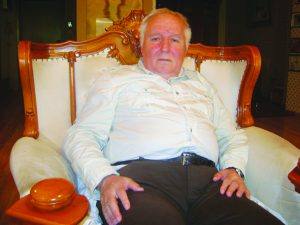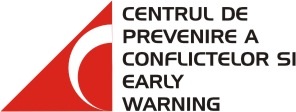 Tiberius PUIU is a journalist and a translator, a member of the Romanian Society of Balkan and Slavic Studies and of the Association of Scandinavian and Baltic Studies. He published a book on “Ukraine and the Ukrainians,” which gives an objective account of the history of Ukraine and tackles the issue of the Holodomor, the great famine of 1933. He was awarded an honorary diploma by the Ukrainian Writers Society. He speaks over 20 foreign languages, he published historical articles in various publications in Romania, the Republic of Moldova, Macedonia, Ukraine and Albania. He translated books from Russian, Albanian, Ukrainian. His opinions on the ex-Soviet and ex-Yugoslavian region have been quoted by the media more than once, or have been expressed by the author himself in various television shows.
Tiberius PUIU is a journalist and a translator, a member of the Romanian Society of Balkan and Slavic Studies and of the Association of Scandinavian and Baltic Studies. He published a book on “Ukraine and the Ukrainians,” which gives an objective account of the history of Ukraine and tackles the issue of the Holodomor, the great famine of 1933. He was awarded an honorary diploma by the Ukrainian Writers Society. He speaks over 20 foreign languages, he published historical articles in various publications in Romania, the Republic of Moldova, Macedonia, Ukraine and Albania. He translated books from Russian, Albanian, Ukrainian. His opinions on the ex-Soviet and ex-Yugoslavian region have been quoted by the media more than once, or have been expressed by the author himself in various television shows.
Can you tell us a few things about the history of the Romanians who live in Timoc Valley?
Timoc Valley is a region inhabited by Romanians ever since the Roman occupation. In fact, there was a population throughout Balkan region, whose language was derived from Latin in the same way as the Romanian language. In the areas that are farther away from the Romanian territory, that language is known as Aromanian and its speakers are called Aromanians, but linguists say the language has the same defining features as the Romanian language. Most of these Balkan natives were called “Vlachs,” both by the Slavic and by the Greek population. In spite of all speculations, there can be no doubt that the name “Vlachs” was given to Romanians for extensive periods, so Romanians and Vlachs are the same thing. The Timoc natives, who lived close to Romania and in rather compact communities, had a chance to preserve their language, which has evolved in roughly the same way as Romanian. In Serbia, the Romanian-speaking people in Timoc were referred to as Romanians, in official documents prior to 1860. The establishment of the United Principalities, later known as Romania, prompted the Serbian authorities to switch to the demonym “Vlachs” for this population, instead of “Romanians.” As the Romanians in Timoc say, if at some point Romania changed its name into Vlachia, the Serbian authorities would revert to the name “Romanians.”
What was the Soviet influence on this part of the Balkans, and how did it affect the Romanians in Timoc?
As I’ve put it before, beyond all differences Yugoslavia saw itself as a smaller USSR; as Stalin once said to Dimitrov, peoples and languages were created, which had not existed before. Today we see Serbia’s authorities creating a Vlach language, although the Romanians in Timoc say they speak “Romanian, not Vlachian.” We cannot ignore the parallel with USSR’s attempt, starting 1924, to create a “Moldovan language” in an effort to push it away from Romanian. Today, Serbia made a great concession, in that television and radio shows are aired in the language of the Timoc population, but that language is not recognisable even for those who view themselves as Vlachs rather than Romanians. The Serbs, who were influenced by Russian policies for so long, must have kept in their archives texts dating back to 1924-1948, when the Moldovan autonomous republic (Transdniester) used phrases like “Ministry of the affairs within” (for “Interior Ministry,” editor’s note). It is true, starting in 1948 the USSR gave up this artificial language, and the main difference between the language spoken in Chişinău and the one in Bucharest had to do with the alphabet. In spite of the mirage of good relations between Romania and Serbia, we must say that the Romanian-speaking communities in Timoc were constantly subject to pressure and discrimination. In 1927 Serbian religious authorities banned the registration of Romanian names or first names by priests. This is why today we have names like Epurovic, Lapadatovic, Ţaranovic, Gaţovic, Roşcanovic. After 1945, there were some official attempts to cultivate the culture of the “Vlach” population. Documents on the efforts of communist partisans include accounts of propaganda actions “in the Vlach language,” the organisation of rallies and other events in that language. But this did not prevent the Yugoslavian authorities from claiming that the “Vlach population” does not have a clearly defined language and alphabet, although various Timoc folklore corpuses, e.g. “Petrecătura” (which speaks about the rituals that accompany the burial of the dead), are models of pure Romanian language. Worth noting is also that until 1982-1983 Romanian children in Timoc were compelled to start school at the age of 6, and they would spend the first year learning Serbian alone. This was a brutal de-nationalisation process. Those children who still dared speak Romanian were punished severely, and their parents would also suffer the consequences. In all the countries in the world, minority children learn the country’s official language, but they are not forced to forget the language of their parents. Unfortunately, Romanian authorities have always paid more attention to the Romanians in Serbian Banat, and they often forget the Romanians in Timoc.
Was there any collaboration between Yugoslavia’s and Romania’s secret services?
There are documents attesting that in 1945-1954 more than half of the Romanians who fled Romania via Yugoslavia, using the Timoc Valley as transit area, were executed, many of them in front of the Romanian ethnics in Timoc. After 1954 the Romanian political police worked closely with and helped the Yugoslavian secret police, among others in arresting one of Tito’s main opponents, in Bucharest. In exchange, when catching Romanian fugitives, the Yugoslavian secret police would check with Bucharest whether the respective person had been sent to infiltrate into the diaspora or had simply fled the country. Those who had left the country without orders were shot, either by the Yugoslavians or by the Romanians. This collaboration between the Romanian political police and the Yugoslavian secret police may be an explanation for the favourable perception of Serbia in Romania, as expressed in the mass media and by the public.
In World War II, Yugoslavia’s army was destroyed in a few days; their sole act of bravery was the bombing of Timişoara and Arad by the Yugoslavian aviation. Yugoslavia had never declared war on Romania, nor the other way round. The unexploded bombs found a few years ago in Timişoara are from those bombings. Although Romania never had territorial claims against Yugoslavia, Yugoslavian troops occupied Timişoara for a long period after the end of World War II, and in 1948, before the break with Stalin, Yugoslavian leaders had requested that the Romanian Banat become Serbian territory. This goal was also promoted by the Slavic Union in Romania, an organisation that disappeared after the Tito-Stalin conflict.
You have recently returned from Timoc Valley. What is the current status of the Romanians living there?
At present, Timoc Valley is witnessing a clash between elements that are under the influence of Serbian authorities and promote a language and alphabet as distinct from Romanian as possible, and the Timoc Romanians who try to oppose this offensive. The Vlach alphabet was put together by a ghost NGO headed by a gynaecologist. I wonder why the National Vlach Committee includes several persons that, because of various influences and pressures, do not want the language spoken by the Romanians in Timoc to be called Romanian. I emphasise once again that the Romanian population defines its language as “Romanian.”
In the 1970s the USSR sought international recognition for the Moldovan language, which was rejected by the International Society of Romance Linguists. The Vlach language will certainly not obtain recognition from any international scientific body. I would also like to add that Poland, an EU member country, has denied the access to Poland and declared as “persona non grata” the leaders of the Polish Union in Belarus, an organisation that backs president Lukashenko. Romanian authorities should do the same with the members of this National Committee, which not only have a hostile attitude towards Romania and the Romanian people, but also betray their forefathers, who preserved the Romanian language, culture and traditions in Timoc Valley for centuries.
Because of the treatment that Timoc Romanians are given by Serbian authorities, Romania objected to Serbia becoming an EU candidate country.
Some may have been surprised by Romania’s last-minute decision, just before the acknowledgment of Serbia as an EU candidate country, but Romania made a statement against the treatment that Romanian ethnics receive in that country. These objections must be furthered and firmly supported.
There are many examples that indicate that Serbian authorities do not shy from resorting to unfair measures. The Belgrade-based television station B92 has recently broadcast a show on the “Vlachs” in Timoc. During the show, history professor Slavoljub Gacovic, from the Museum of Zaječar, presented arguments in favour of the Romanian ethnicity of the “Vlachs,” including “Vlach” folk costumes on display in the Zaječar museum. The show was otherwise objective, without any attacks against Serbian authorities. However, in the irritation that followed, the museum director ordered an “investigation” and, based on unreasonable arguments (i.e. that the show had to had prior authorisation), he prohibited professor Gacovic’s access to the museum for an indefinite period. If an authorisation had indeed been required, it should have been obtained by the B92 television station, and not by professor Gacovic, who was a guest in the show. The life of Timoc Romanians is full of such vexations. This is why what has been done so far is only a beginning, and pressure on Serbia must not be reduced, if we are to avoid tragic consequences for those who declared their Romanian roots. The Serbian chauvinism is on a par with the Russian one: the loss of an empire prompted a “vengeful” attitude towards minorities.
(Interview by Virginia MIRCEA









